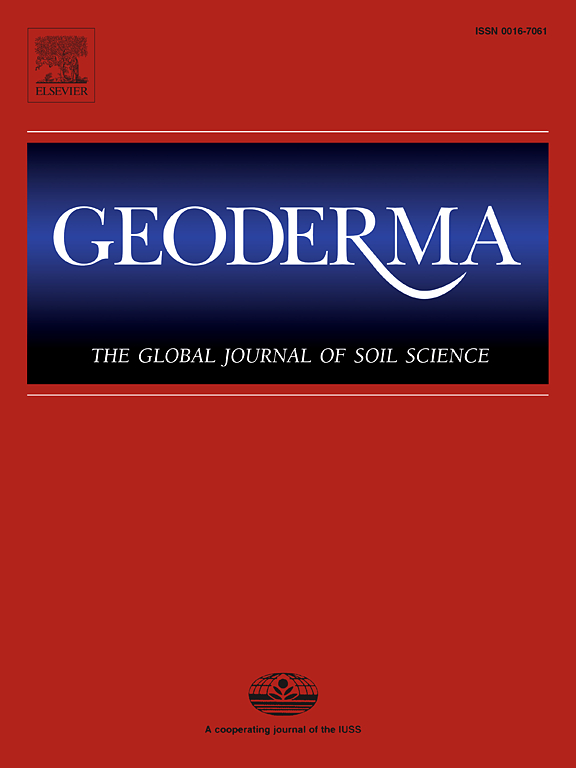Spatial distribution of microplastics in Mollisols of the farmland in Northeast China: the role of field management and plastic sources
IF 6.6
1区 农林科学
Q1 SOIL SCIENCE
引用次数: 0
Abstract
Although microplastics (MPs) have been widely found in farmland soil, the influence of pollutant sources and farmland management on MPs migration and distribution is poorly understood. In this study, we investigated the distribution of MPs in the 0–30 cm soil layers of vegetable fields with long-term mulching and surrounded by complex pollution sources under three management methods (MMs) (MM1, high fertilization dose and moderate tillage frequency; MM2, moderate fertilization dose and high tillage frequency; MM3, low fertilization dose and low tillage frequency) in Mollisols of Northeast China. Geostatistics combined with classical statistics were used to clarify the distribution of MPs and their driving factors. The results indicated that the polyethylene (PE), polypropylene (PP), polyvinyl chloride (PVC), polystyrene (PS), polyethylene terephthalate (PET), polyether urethane (PEUR) and a mixture of “PE and PP” (PE:PP) were found in the 0–30 cm soil layer. The dominant sizes of PE-MPs and non-PE-MPs (NPE-MPs) were 1–5 mm and <1.0 mm in the 0–30 cm soil layer. The abundance of MPs was higher in the 20–30 cm soil layer near the irrigation wells than in the 0–20 cm soil layer, and the spatial distribution of MPs was random in both layers. The distances from sampling points to the polluted sources (e.g., residential area, landfill and single farmhouse) were not significantly correlated (p > 0.05) with the abundance of MPs in the 0–30 cm soil layer, but were significantly correlated (p < 0.05) with the abundance of MaPs. The effect of fertilization dose (0.201–0.248) on the abundance of MPs was greater than that of tillage frequency (0.170–0.188). Generally, the distribution of MPs was directly affected by the distribution of MaPs in the farmland soil, while the polluted sources surrounding the farmland indirectly affected the distribution of MPs by influencing the MaPs sources. MPs formation was more affected by fertilization than by tillage. This study clarified the effects of pollution sources and MMs on the distribution of MPs in farmland soils, and provided guidance for better management of MPs contamination in farmlands.

东北农田土壤中微塑料的空间分布:田间管理和塑料来源的作用
虽然微塑料在农田土壤中广泛存在,但污染源和农田管理对微塑料迁移和分布的影响尚不清楚。本研究采用三种管理方法(MM1、高施肥量和中等耕作频率;MM2,适度施肥,高频次;MM3(低施肥剂量和低耕作频率)在东北软土中的应用。采用地质统计学与经典统计学相结合的方法,对MPs的分布及其驱动因素进行了分析。结果表明:0 ~ 30 cm土层中存在聚乙烯(PE)、聚丙烯(PP)、聚氯乙烯(PVC)、聚苯乙烯(PS)、聚对苯二甲酸乙二醇酯(PET)、聚醚氨基甲酸乙酯(PEUR)和“PE与PP”混合物(PE:PP)。在0 ~ 30 cm土层中,PE-MPs和非PE-MPs (NPE-MPs)的优势尺寸分别为1 ~ 5 mm和1.0 mm。灌井附近20 ~ 30 cm土层MPs丰度高于0 ~ 20 cm土层,且MPs在两层的空间分布具有随机性。从采样点到污染源(如居民区、垃圾填埋场和单一农家院)的距离没有显著相关(p >;0.05)与0 ~ 30 cm土层MPs丰度呈显著相关(p <;0.05),与map丰度呈正相关。施肥剂量(0.201 ~ 0.248)对MPs丰度的影响大于耕作频率(0.170 ~ 0.188)。一般来说,MPs的分布直接受到农田土壤中map分布的影响,而农田周围污染源通过影响map源间接影响MPs的分布。施肥对MPs形成的影响大于耕作。本研究阐明了污染源和mm对农田土壤中MPs分布的影响,为更好地管理农田MPs污染提供指导。
本文章由计算机程序翻译,如有差异,请以英文原文为准。
求助全文
约1分钟内获得全文
求助全文
来源期刊

Geoderma
农林科学-土壤科学
CiteScore
11.80
自引率
6.60%
发文量
597
审稿时长
58 days
期刊介绍:
Geoderma - the global journal of soil science - welcomes authors, readers and soil research from all parts of the world, encourages worldwide soil studies, and embraces all aspects of soil science and its associated pedagogy. The journal particularly welcomes interdisciplinary work focusing on dynamic soil processes and functions across space and time.
 求助内容:
求助内容: 应助结果提醒方式:
应助结果提醒方式:


